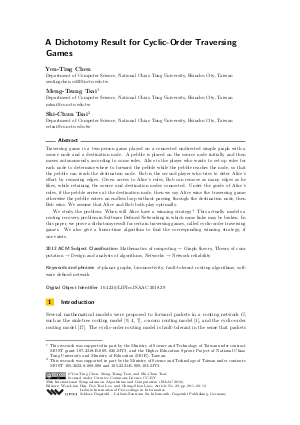A Dichotomy Result for Cyclic-Order Traversing Games
Authors Yen-Ting Chen, Meng-Tsung Tsai, Shi-Chun Tsai
-
Part of:
Volume:
29th International Symposium on Algorithms and Computation (ISAAC 2018)
Part of: Series: Leibniz International Proceedings in Informatics (LIPIcs)
Part of: Conference: International Symposium on Algorithms and Computation (ISAAC) - License:
 Creative Commons Attribution 3.0 Unported license
Creative Commons Attribution 3.0 Unported license
- Publication Date: 2018-12-06
File

PDF
LIPIcs.ISAAC.2018.29.pdf
- Filesize: 483 kB
- 13 pages
Document Identifiers
Subject Classification
ACM Subject Classification
- Mathematics of computing → Graph theory
- Theory of computation → Design and analysis of algorithms
- Networks → Network reliability
Keywords
- st-planar graphs
- biconnectivity
- fault-tolerant routing algorithms
- software defined network
Metrics
- Access Statistics
-
Total Accesses (updated on a weekly basis)
0Document
0Metadata
Abstract
Traversing game is a two-person game played on a connected undirected simple graph with a source node and a destination node. A pebble is placed on the source node initially and then moves autonomously according to some rules. Alice is the player who wants to set up rules for each node to determine where to forward the pebble while the pebble reaches the node, so that the pebble can reach the destination node. Bob is the second player who tries to deter Alice's effort by removing edges. Given access to Alice's rules, Bob can remove as many edges as he likes, while retaining the source and destination nodes connected. Under the guide of Alice's rules, if the pebble arrives at the destination node, then we say Alice wins the traversing game; otherwise the pebble enters an endless loop without passing through the destination node, then Bob wins. We assume that Alice and Bob both play optimally. We study the problem: When will Alice have a winning strategy? This actually models a routing recovery problem in Software Defined Networking in which some links may be broken. In this paper, we prove a dichotomy result for certain traversing games, called cyclic-order traversing games. We also give a linear-time algorithm to find the corresponding winning strategy, if one exists.
Cite As Get BibTex
Yen-Ting Chen, Meng-Tsung Tsai, and Shi-Chun Tsai. A Dichotomy Result for Cyclic-Order Traversing Games. In 29th International Symposium on Algorithms and Computation (ISAAC 2018). Leibniz International Proceedings in Informatics (LIPIcs), Volume 123, pp. 29:1-29:13, Schloss Dagstuhl – Leibniz-Zentrum für Informatik (2018)
https://doi.org/10.4230/LIPIcs.ISAAC.2018.29
BibTex
@InProceedings{chen_et_al:LIPIcs.ISAAC.2018.29,
author = {Chen, Yen-Ting and Tsai, Meng-Tsung and Tsai, Shi-Chun},
title = {{A Dichotomy Result for Cyclic-Order Traversing Games}},
booktitle = {29th International Symposium on Algorithms and Computation (ISAAC 2018)},
pages = {29:1--29:13},
series = {Leibniz International Proceedings in Informatics (LIPIcs)},
ISBN = {978-3-95977-094-1},
ISSN = {1868-8969},
year = {2018},
volume = {123},
editor = {Hsu, Wen-Lian and Lee, Der-Tsai and Liao, Chung-Shou},
publisher = {Schloss Dagstuhl -- Leibniz-Zentrum f{\"u}r Informatik},
address = {Dagstuhl, Germany},
URL = {https://drops.dagstuhl.de/entities/document/10.4230/LIPIcs.ISAAC.2018.29},
URN = {urn:nbn:de:0030-drops-99775},
doi = {10.4230/LIPIcs.ISAAC.2018.29},
annote = {Keywords: st-planar graphs, biconnectivity, fault-tolerant routing algorithms, software defined network}
}
Author Details
- Department of Computer Science, National Chiao Tung University, Hsinchu City, Taiwan
Funding
- Tsai, Meng-Tsung: This research was supported in part by the Ministry of Science and Technology of Taiwan under contract MOST grant 107-2218-E-009- 026-MY3, and the Higher Education Sprout Project of National Chiao Tung University and Ministry of Education (MOE), Taiwan.
- Tsai, Shi-Chun: This research was supported in part by the Ministry of Science and Technology of Taiwan under contracts MOST 105-2622-8-009-008 and 105-2221-E-009-103-MY3.
References
-
Fred S. Annexstein, Kenneth A. Berman, Tsan-Sheng Hsu, and Ram Swaminathan. A multi-tree routing scheme using acyclic orientations. Theoretical Computer Science, 240(2):487-494, 2000.

-
Sanjeev Arora and Boaz Barak. Computational Complexity: A Modern Approach. Cambridge University Press, 2009.

- Giorgio Ausiello, Paolo Giulio Franciosa, Isabella Lari, and Andrea Ribichini. Max flow vitality in general and planar graphs. CoRR, abs/1710.01965, 2017. URL: http://arxiv.org/abs/1710.01965.
-
Dimitri P. Bertsekas and Robert G. Gallager. Data Networks, Second Edition. Prentice Hall, 1992.

-
Gary Chartrand and Frank Harary. Planar permutation graphs. Annales de l'Institut Henri Poincaré B, 3(4):433-438, 1967.

-
Norishige Chiba, Takao Nishizeki, Shigenobu Abe, and Takao Ozawa. A linear algorithm for embedding planar graphs using PQ-Trees. Journal of Computer and System Sciences, 30(1):54-76, 1985.

-
Reuven Cohen, Baiju V. Patel, Frank Schaffa, and Marc Willebeek-LeMair. The Sink Tree Paradigm: Connectionless Traffic Support on ATM LAN’s. IEEE/ACM Trans. Netw., 4(3):363-374, 1996.

-
Ding-Zhu Du and Ker-I Ko. Theory of Computational Complexity, Second Edition. Wiley, 2014.

-
Eli M. Gafni and Dimitri P. Bertsekas. Distributed algorithms for generating loop-free routes in networks with frequently changing topology. IEEE Trans. Comm., 29:11-18, 1981.

-
Frank Harary. Graph theory. Addison-Wesley, 1991.

- John Hopcroft and Robert Tarjan. Algorithm 447: Efficient Algorithms for Graph Manipulation. Commun. ACM, 16(6):372-378, June 1973. URL: http://dx.doi.org/10.1145/362248.362272.
-
John Hopcroft and Robert Tarjan. Efficient planarity testing. Journal of the Association for Computing Machinery, 21:549–568, 1974.

-
Tsan-sheng Hsu and Ming-Yang Kao. A Unifying Augmentation Algorithm for Two-Edge Connectivity and Biconnectivity. J. Comb. Optim., 2(3):237-256, 1998.

-
Bernhard Korte and Jens Vygen. Combinatorial Optimization: Theory and Algorithms. Springer Publishing Company, Incorporated, 6th edition, 2018.

- Casimir Kuratowski. Sur le problème des courbes gauches en Topologie. Fundamenta Mathematicae, 15(1):271-283, 1930. URL: http://eudml.org/doc/212352.
-
A. Lempel, S. Even, and I. Cederbaum. An Algorithm for Planarity Testing of Graphs. In Theory of Graphs, International Symposium, pages 215-232, 1966.

-
Y.-Z. Liao and S.-C. Tsai. Fast Failover with Hierarchical Disjoint Paths in SDN. In IEEE Global Communications Conference (GLOBECOM), 2018.

-
Nick McKeown, Tom Anderson, Hari Balakrishnan, Guru Parulkar, Larry Peterson, Jennifer Rexford, Scott Shenker, and Jonathan Turner. OpenFlow: enabling innovation in campus networks. ACM SIGCOMM Computer Communication Review, 38:69-74, 2008.

- SDN. https://www.opennetworking.org/sdn-resources/sdn-definition. [Online].
-
Pierre Rosenstiehl and Robert E. Tarjan. Rectilinear Planar Layouts and Bipolar Orientations of Planar Graphs. Discrete Comput. Geom., 1(4):343-353, December 1986.

-
W.-K. Shih and W.-L Hsu. A new planarity test. Theo. Comput. Sci., 223:179–191, 1999.

